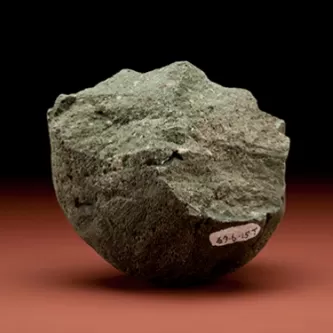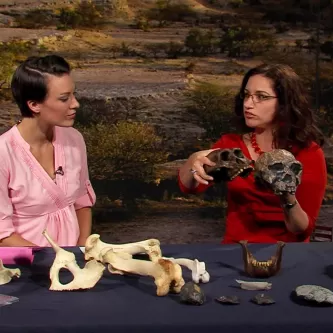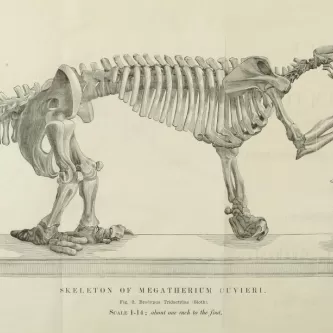Search
Human Evolution
Six Million Years of Human Evolution
Human evolution is the lengthy process of change by which people originated from apelike ancestors. Scientific evidence shows that the physical and behavioral traits shared by all people originated from apelike ancestors and evolved over a period of approximately six million years.
Paleoanthropology is the scientific study of human evolution which investigates the origin of the universal and defining traits of our species. The field involves an understanding of the similarities and differences between humans and other species in their genes, body form, physiology, and behavior. Paleoanthropologists search for the roots of human physical traits and behavior. They seek to discover how evolution has shaped the potentials, tendencies, and limitations of all people.
What Can Human Fossils Tell Us?
Early human fossils and archeological remains offer the most important clues about this ancient past. These remains include bones, tools and any other evidence (such as footprints, evidence of hearths, or butchery marks on animal bones) left by earlier people. Usually, the remains were buried and preserved naturally. They are then found either on the surface (exposed by rain, rivers, and wind erosion) or by digging in the ground. By studying fossilized bones, scientists learn about the physical appearance of earlier humans and how it changed. Bone size, shape, and markings left by muscles tell us how those predecessors moved around, held tools, and how the size of their brains changed over a long time.
Archeological evidence refers to the things earlier people made and the places where scientists find them. By studying this type of evidence, archeologists can understand how early humans made and used tools and lived in their environments.
Humans and Our Evolutionary Relatives
Humans are primates. Physical and genetic similarities show that the modern human species, Homo sapiens, has a very close relationship to another group of primate species, the apes. Modern humans and the great apes (large apes) of Africa – chimpanzees (including bonobos, or so-called “pygmy chimpanzees”) and gorillas – share a common ancestor that lived between 8 and 6 million years ago.
Humans first evolved in Africa, and much of human evolution occurred on that continent. The fossils of early humans who lived between 6 and 2 million years ago come entirely from Africa. Early humans first migrated out of Africa into Asia probably between 2 million and 1.8 million years ago. They entered Europe somewhat later, between 1.5 million and 1 million years. Species of modern humans populated many parts of the world much later. For instance, people first came to Australia probably within the past 60,000 years and to the Americas within the past 15,000 years or so.
Most scientists currently recognize some 15 to 20 different species of early humans. Scientists do not all agree, however, about how these species are related or which ones simply died out. Many early human species – certainly the majority of them – left no living descendants. Scientists also debate over how to identify and classify particular species of early humans, and about what factors influenced the evolution and extinction of each species.
Human Characteristics
One of the earliest defining human traits, bipedalism – the ability to walk on two legs – evolved over 4 million years ago. Other important human characteristics – such as a large and complex brain, the ability to make and use tools, and the capacity for language – developed more recently. Many advanced traits -- including complex symbolic expression, art, and elaborate cultural diversity – emerged mainly during the past 100,000 years. The beginnings of agriculture and the rise of the first civilizations occurred within the past 12,000 years.
Smithsonian Research Into Human Evolution
The Smithsonian’s Human Origins Program explores the universal human story at its broadest time scale. Smithsonian anthropologists research many aspects of human evolution around the globe, investigating fundamental questions about our evolutionary past, including the roots of human adaptability.
For example, Paleoanthropologist Dr. Rick Potts – who directs the Human Origins Program – co-directs ongoing research projects in southern and western Kenya and southern and northern China that compare evidence of early human behavior and environments from eastern Africa to eastern Asia. Rick’s work helps us understand the environmental changes that occurred during the times that many of the fundamental characteristics that make us human - such as making tools and large brains – evolved, and that our ancestors were often able to persist through dramatic climate changes. Rick describes his work in the video Survivors of a Changing Environment.
Dr. Briana Pobiner is a Prehistoric Archaeologist whose research centers on the evolution of human diet (with a focus on meat-eating), but has included topics as diverse as cannibalism in the Cook Islands and chimpanzee carnivory. Her research has helped us understand that at the onset of human carnivory over 2.5 million years ago some of the meat our ancestors ate was scavenged from large carnivores, but by 1.5 million years ago they were getting access to some of the prime, juicy parts of large animal carcasses. She uses techniques similar to modern day forensics for her detective work on early human diets.
Paleoanthropologist Dr. Matt Tocheri conducts research into the evolutionary history and functional morphology of the human and great ape family, the Hominidae. His work on the wrist of Homo floresiensis, the so-called “hobbits” of human evolution discovered in Indonesia, received considerable attention worldwide after it was published in 2007 in the journal Science. He now co-directs research at Liang Bua on the island of Flores in Indonesia, the site where Homo floresiensis was first discovered.
Geologist Dr. Kay Behrensmeyer has been a long-time collaborator with Rick Potts’ human evolution research at the site of Olorgesailie in southern Kenya. Kay’s role with the research there is to help understand the environments of the sites at which evidence for early humans – in the form of stone tools as well as fossils of the early humans themselves – have been found, by looking at the sediments of the geological layers in which the artifacts and fossils have been excavated.


